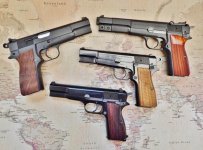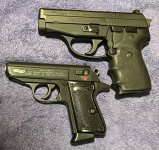Glock leg was actually created by 1911 shooters handling a Glock without proper supervision. You know, kind of like taking the training wheels off a bicycle.

I’ll need to see a credible source for that.
It’s a training issue. Glocks were marketed with the sales pitch that they would require very little training to transition police officers from DA/SA or DAO revolvers to a Glock as all of the safeties were tied to the trigger and thus there was no need to learn to use a safety lever or decocking lever.
It’s partly true as far as using a Glock in a duty holster. However if you’ve been around long enough you’ll recognize that the advent of striker fired pistols precipitated duty holsters that started being much farther away from the shooter. Those holsters literally helped provide more space to prevent “Glock leg” incidents:
- when an excited officer (especially when using a retention holster with a release near the trigger) got overly exited and got their trigger finger inside the trigger guard before the pistol was pointed down range and/or
- when an excited officer tried to reholster the pistol without taking their trigger finger out of the trigger guard.
It’s even worse for concealed carry where an IWB or OWB holster worn close to the body creates potential conflicts with shirt or jacket material, draw strings, etc, that may get between the trigger and the edge of the holster.
It can be remediated with proper holster design, where the holster can be readily removed to reholster the pistol out in front of the shooter where he can clearly confirm there are no obstructions, or at a minimum with a holster deign and location that allows the shooter to visually confirm the lack of obstructions.
Unfortunately, some shooters (the moron) will use things like those clips that attach to slide so they can stuff a striker fired pistol in their waistband with nothing at all protecting the trigger.
The Glock also has to fired before it can be disassembled, which requires the person cleaning it to fully understand how to clear it before attempting to disassemble it. You’d think that would not be an issue, and yet officers have a depressing number of NDs doing exactly that. Most of them after all are not “gun people”.
——
In short the Glock did not in fact require less training. It required different training in how to safely handle the pistol.
That’s not much different than a 1911, where officers were taught to not disengage the safety until the pistol was pointed down range, and to a) apply the manual safety, b) place their thumb between the hammer and slide, which c) also lifted their hand off the grip safety, when reholstering the pistol. An officer would have to forget all three, plus have his finger on the trigger to have an ND when reholstering.



